Recent Fire Damage Posts
Fire Safety Tips for Every Room of the House
6/23/2022 (Permalink)
The unfortunate truth about household fires is that they can start for a myriad of reasons. From cooking incidents to improperly stored flammable items, many accidents can lead to a fire, which is why it is so vital to practice fire prevention throughout the house.
Making sure that you and every member of your household are aware of common fire hazards can help you all go about your lives with safety in mind, which drastically reduces the likelihood that you will wind up with a fire on your hands. Read on to learn about fire safety tips you should know for every room.
Kitchen Fire Safety Tips
Kitchens are the room in the home where a fire is most likely to break out, so it is extra important to be vigilant. Make sure there is nothing flammable near your stove or oven (including curtains, dish towels and potholders) and that food is never left unattended on the stove. It is also important to keep a fire extinguisher handy in case of any flare-ups, and ensure everyone in the home knows how to handle a grease fire as opposed to a regular fire.
Family Room Fire Safety Tips
While family rooms do not typically contain as many fire hazards as other areas of the home, there are still risks to consider. Don’t leave candles burning unattended, and if you have a fireplace, make sure it is inspected regularly by a certified professional. For electronics, be sure to not overload electrical outlets and replace cords and cables if they become frayed or worn out.
Garage and Storage Fire Safety Tips
Storage areas such as garages or basements can often become cluttered, which can lead to an excess of fire hazards. Make sure any flammable materials, such as lighter fluid or chemicals, are stored properly and are not able to get too hot in the summer months. Also be certain that these areas have clear and accessible exits free from clutter that could block someone’s path should they need to escape quickly.
*If you have damage to your home due to a house fire, you can count on us to help. Get in touch with us today to learn more about how our fire restoration services work.
Fire Safety Tips for the Whole Family
6/7/2022 (Permalink)
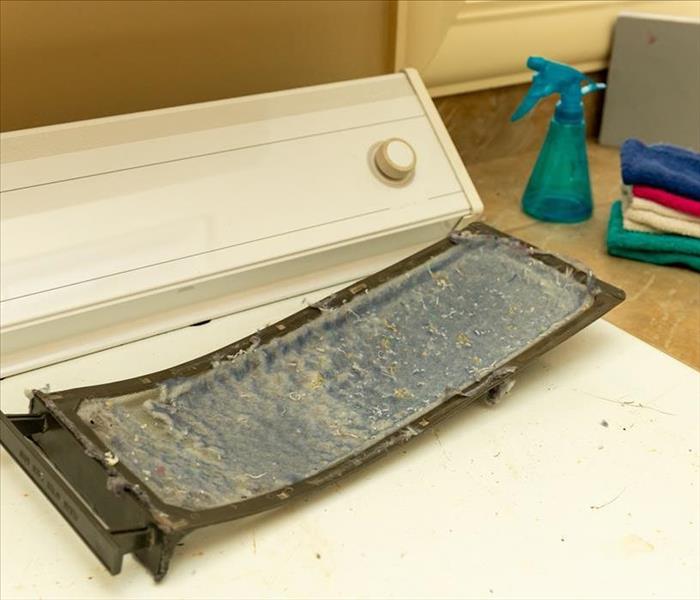 SERVPRO of Paulding/Polk Counties is ready 24 hours a day to help you fight fire damage.
SERVPRO of Paulding/Polk Counties is ready 24 hours a day to help you fight fire damage.
Fire safety is such an important thing for any household. House fires can be dangerous and traumatic, causing significant household damage and putting anyone in the vicinity directly in
harm’s way. Fortunately, fire safety is also a goal that the entire family can get involved with, keeping everyone more invested in safety and more prepared, just in case.
Many fire safety tips are things the entire family can participate in, which makes it a great family activity. Depending on who is in your household, it may be necessary to adjust some of these tips accordingly—for example, toddlers may have a great time drawing escape plans, while older kids may be more suited to smoke detector test duty.
However, we hope these general guidelines are helpful in getting everyone on the same page
for your home’s fire safety.
Fire Safety Tasks for Young Children
**Drawing an escape route.** Escaping quickly is key when it comes to a house fire, so an escape plan is a must. Young children can often be helpful here, drawing lines from each room
to indicate every exit.
**Being accountable for hazards.** Unattended candles, space heaters and cooking food can all be major fire hazards. Oftentimes, young children can make great safety accountability buddies,
calling out these hazards when they notice them.
Fire Safety Tasks for Older Children
**Checking smoke detectors.** Smoke detectors should be tested monthly, which can often be a great chore for preteens and teens in the home.
**Managing fire escape drills.** It is important to have a fire escape plan, and just as important to practice it regularly. Older children can be great at managing these drills, from planning them
out to debriefing as a family in order to see where there may be room for improvement.
**Cleaning out the dryer lint trap.** If your older children do their own laundry, it is important that they understand the importance of cleaning out the dryer lint trap. This is a commonly overlooked fire hazard, but the lint can heat up while the dryer is running and lead to a fire.
*If you have household damage due to a fire, we are here to help. Contact us today to learn more about our fire restoration options or get in touch 24/7 for a rapid response.
Fire Safety & HVAC Maintenance
4/26/2022 (Permalink)
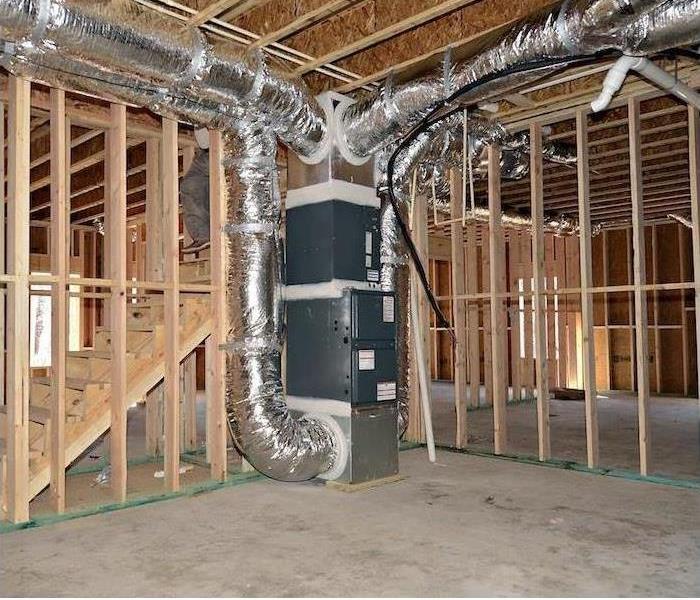 If fire should become a problem, contact the pros in green, SERVPRO of Paulding/Polk
If fire should become a problem, contact the pros in green, SERVPRO of Paulding/Polk
Being a responsible homeowner means taking care of the things that take care of you. Your HVAC system is always there, and there are few (if any) days per year in our area where you aren’t relying on it to keep your home comfortable. It often goes unappreciated—that is, until something goes south or stops working.
There are also some important fire safety concerns of which you need to remain aware, particularly as winter comes in and your HVAC switches to heating mode. Don’t let your source of comfort turn into a source of disaster.
Here’s what you need to do to make sure your HVAC system and furnace are running safely this fall and winter.
Routine Maintenance
Ideally, your HVAC system should be checked twice a year for any present or upcoming issues. A professional can see problems coming and head them off before any danger is presented.
Things like aging or fraying wiring can become fire hazards that are exacerbated by the extended use of HVAC systems during less pleasant times of the year.
Duct System Circulation
Overworked heating systems are dangerous heating systems, and one thing that can quickly cause your system to work too hard is allowing your ductwork to become or remain clogged. Poor circulation or ventilation can cause your furnace to overheat.
It’s recommended that you have your duct work cleaned every three to five years, and we can help with that.
Declutter Your Furnace Area
If your furnace is located in a designated area, or it’s in the corner of a basement or garage, make sure the two-foot radius around it is clear of clutter. Radiating heat (and certainly direct contact) from the furnace can cause flammable materials to ignite. Resist the urge to use your furnace area for storage.
Install Carbon Monoxide Detectors
If your furnace is gas-powered, carbon monoxide detectors can be as important for you as smoke alarms. The gas in your furnace is odorless, and you may not notice a leak until it’s too late. A detector can give you the assurance that things are running smoothly.
In addition to your regular fall maintenance, make sure to have your heating unit examined to give yourself a comfortable, fire-safe fall and winter season.
If fire should become a problem at home, we can help you with restoration and recovery. Contact SERVPRO to get the pros in green working for you right away.
Why You Should Trust SERVPRO with Your Fire Damage Recovery
4/21/2022 (Permalink)
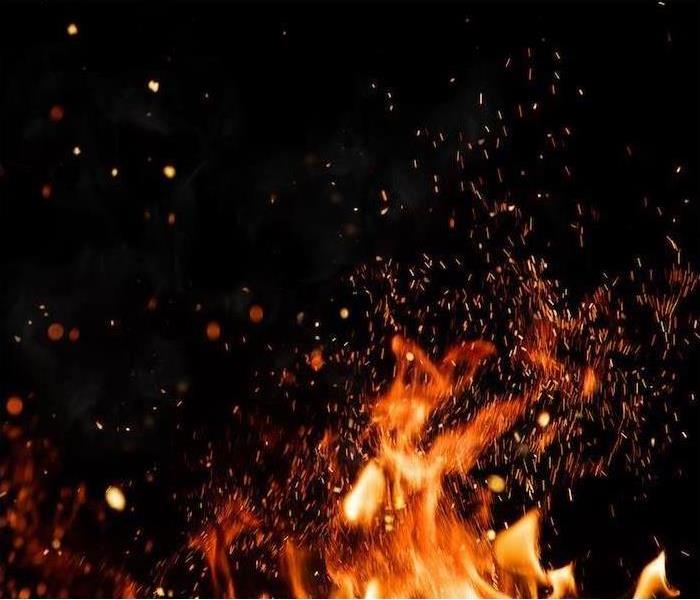 SERVPRO of Paulding/Polk is your local fire restoration expert. No job is too big for our team of experts.
SERVPRO of Paulding/Polk is your local fire restoration expert. No job is too big for our team of experts.
Dealing with a fire is one of the most taxing things a homeowner could possibly imagine.
Fire causes all kinds of damage in your home, and recovering from a home fire encompasses dealing with physical, financial, emotional and mental recovery.
While SERVPRO of Paulding/Polk can’t help with all these areas, we can be your main source of property recovery and restoration. And we can get your home taken care of quickly, which can in turn aid in your emotional recovery as well.
Here’s why you know you can feel good about entrusting your fire recovery to us.
We’re Established.
We’ve been doing this a very long time. SERVPRO was established the same year Thurgood Marshall was appointed to the Supreme Court, if that gives you any idea.
That means we’ve got over 50 years’ experience helping families and homeowners deal with the effects of fire, and we’ll use all those years of innovation and experience to give you the most complete recovery possible.
We’re Skilled.
SERVPRO of Paulding/Polk employs a team of experts, trained and equipped to handle anything fire may have done to your home. From reversing the effects of smoke damage to full-blown rebuilding efforts, we have the tools and work ethic to get it done.
We’re always up to date on the latest technologies, innovations and certifications, which multiplies our capacity for tackling even the toughest recovery projects.
We’re Very Fast.
When you click this link or call (770)-505-0555 you’re getting connected with a local team who can be onsite right away to get started.
You don’t have to wait for a team from somewhere else to mosey up to Dallas or Hiram—no, we’re right here in Dallas which means when you need us, we’re the quickest option for your recovery. And we’re on call 24 hours a day, seven days a week to take your emergency call.
When fire strikes at home, the choice is clear: SERVPRO of Paulding/Polk Counties is the name you can trust with your recovery and restoration.
If fire or other disasters do damage to your home, we’re here to make things right again. Contact us today to get fast, local recovery started on your property right away.
Tips For Recovering After a House Fire
4/6/2022 (Permalink)
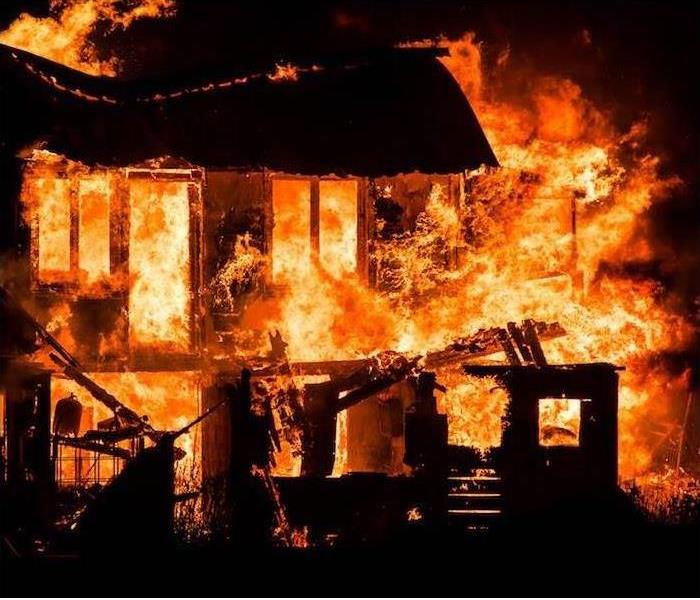 House fires trend to peak during the winter. SERVPRO of Paulding/Polk counties is available 24/7 in the event of an emergency.
House fires trend to peak during the winter. SERVPRO of Paulding/Polk counties is available 24/7 in the event of an emergency.
No one likes to think about suffering a loss like a house fire, but it’s a reality for millions of American families every year. House fires aren’t a seasonal risk to your home, but they do happen more frequently during the winter months.
If your family suffers a house fire, even one that does extensive damage, you can take steps to recover what you can from your home and recover emotionally, too. These tips can help you start the restoration process and help you deal with the aftermath of a house fire.
Taking the First Steps
The American Red Cross offers the following tips to help you in the immediate aftermath of a house fire.
After you’ve gotten everyone out of the house and treatment for any injured people or pets, then these are your next steps:
Let your loved ones know you’re safe. This is an important step, especially when news of a fire or issue can spread quickly.
Don’t go back into your home until it’s secured. The authorities will let you know when it’s safe to go back to your house. Please don’t go in there before because it can be unsafe.
Get in touch with your insurance company. You’ll want to let them know what happens to get the restoration process started.
Tips for Dealing With Emotions
It’s normal to feel a wide range of emotions after your home suffers a fire. They can range from grief to anger to depression. The American Psychological Association offers this advice to help you begin the process of recovering emotionally.
Find ways to reduce your stress. That can include exercise, meditation and deep breathing.
Don’t make major life decisions. It’s smart to avoid switching jobs or making other major choices while dealing with these complicated emotions.
Talk about your feelings. Whether you choose a therapist, family members or a close friend, it’s smart to talk to someone about what’s going on.
Don’t set expectations. There is no way you “should” be dealing with these issues. Instead, do what you can and be kind to yourself.
Take good care of yourself. Eat balanced meals and get plenty of sleep. It will help you better deal with a stressful situation.
If your home is damaged due to a fire or any other cause, you can always count on us for restoration assistance. We have crews who are available 24⁄7 in the event of an emergency. Contact us at any time to learn more about our restoration services and how we can help.
SERVPRO's Process for Fire Restoration
4/2/2022 (Permalink)
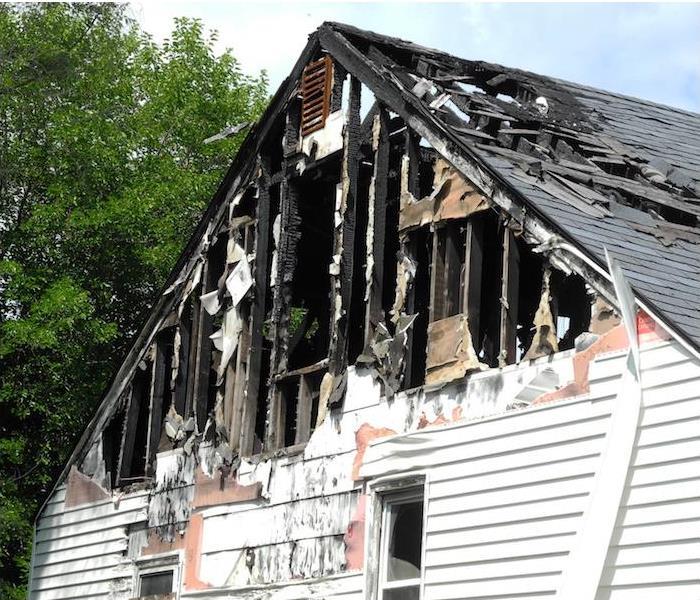 When your home or business endures fire damage, you can count on SERVPRO of Paulding/Polk from start to finish.
When your home or business endures fire damage, you can count on SERVPRO of Paulding/Polk from start to finish.
After a fire strikes your home or business, you’re left with damage from the fire as well as water saturating everything from the firefighting efforts. None of that would be a surprise to our experts here at SERVPRO, as we have the specialized fire restoration expertise to return your house to its pre-fire state.
Every fire damage situation is unique and necessitates a unique remedy, but the overall procedure remains the same. The following is how we will handle a “normal” fire damage situation.
Initial contact. We are on call 24 hours a day and seven days a week, including all holidays. Disaster doesn’t wait for office hours to strike, and we don’t wait to respond. When you contact us, the restoration procedure starts. Our experts will ask a number of questions about the fire damage so that we can get started immediately with the necessary equipment and resources.
Inspection. To establish the degree of the fire, water, smoke and soot damage, we will thoroughly check and test every room. By doing this, we are able to formulate the proper strategy. Fires can cause the air quality to be unsafe, so it’s important not to re-enter the property until experts have determined it is safe to do so.
Water removal. If there is water damage present as a result of firefighting efforts or sprinkler systems, we will begin the water removal procedure immediately to ensure the bulk of the water is removed. If there is any remaining water, it will be removed using dehumidifiers and fans, and the drying process will begin from there.
Cleaning. SERVPRO removes smoke and soot from ceilings, walls and other surfaces using highly specialized state-of-the-art equipment and processes. We’ll clean up all of the fire-damaged items and areas that can be cleaned and repaired. We will also work to return your possessions to their pre-fire state by applying a number of cleaning processes. We can clean and restore electronics, documents, upholstery and more. We also specialize in industrial air scrubbers and fogging equipment to eliminate odors.
Restoration. If during the cleaning process we determine that certain areas of your property cannot be cleaned, we also provide comprehensive restoration and rebuilding services. Restoration and rebuilding efforts include everything from modest repairs like drywall replacement, painting or carpet installation to substantial repairs like the complete rebuilding of different areas or rooms in your home or property.
When your home or business endures fire damage, you can trust that SERVPRO of Paulding/Polk Counties will be ready to be a helping hand and will get your home restored quickly and thoroughly to its pre-fire condition.
A Guide to Fire Code Considerations for Your Commercial Space
3/30/2022 (Permalink)
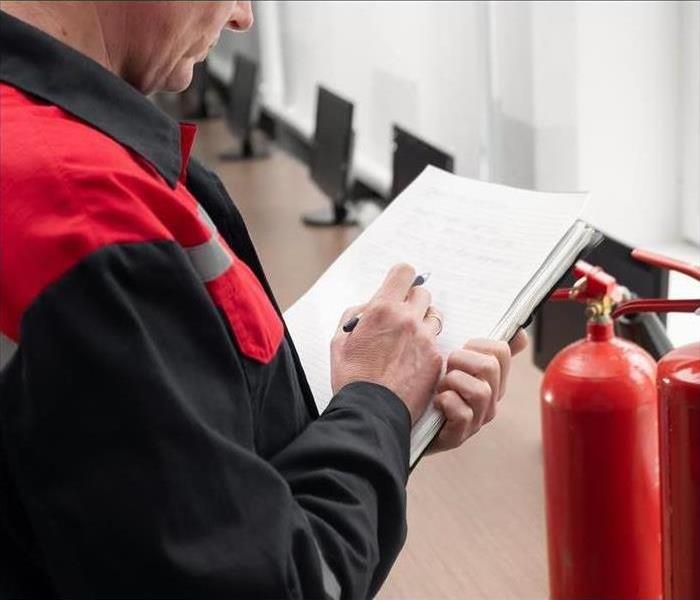 If your business needs help with fire damage, you can count on SERVPRO of Paulding/Polk counties 24/7/365.
If your business needs help with fire damage, you can count on SERVPRO of Paulding/Polk counties 24/7/365.
If you own or operate a business or other commercial space, understanding how to protect your investment and your employees from harm related to fire damage is a must. Not only are fires extremely dangerous for anyone who is in the area, but they can also be devastating to businesses—it is estimated that over half of businesses are unable to recover from a fire.
Fortunately, businesses are able to take many precautions when it comes to fire prevention, and national commercial fire codes are a great place to start. While each area will have their own local codes that should also be followed, below, we will examine some of the national codes that can help you keep your business safe and operational.
Fire Codes Pertaining to Commercial Sprinkler Systems
While they are not required in all types of commercial buildings, a commercial fire sprinkler system can be a fantastic way to reduce the risk of a fire severely impacting your business. Typically, the rules for fire sprinkler systems are that they must be installed in any commercial building over 5,000 square feet and any building that is taller than 55 feet in height.
Fire Codes Pertaining to Fire Alarms
While smaller commercial spaces are not always required to have a fire alarm system, installing them is a simple enough process that it is always a good idea. By alerting people to the fire quickly, your employees and customers will have more time to escape, which could potentially save a life. If possible, it is best to invest in interconnected fire alarms, so that when one is triggered, they will all sound to alert everyone in the area.
Fire Codes Pertaining to Fire Extinguishers
All businesses are required to have fire extinguishers on the premises, but how many and where they should be located varies based on the size and nature of the commercial space in question. Additionally, business owners are required to have fire extinguisher training with all employees at least once per year to be certain that everyone is aware of how to use a fire extinguisher and comfortable with the best practices.
If your business needs help with fire damage, you can count on us. We are here 24 hours a day to help you recover in the aftermath of a commercial fire. Contact us today to learn more.
Keeping Track of Fire Safety at Your Business
3/25/2022 (Permalink)
 If you are dealing with the aftermath of a fire at your business, you can depend on SERVPRO of Paulding/Polk Counties
If you are dealing with the aftermath of a fire at your business, you can depend on SERVPRO of Paulding/Polk Counties
For business owners, there are few things more important for the safety of you and your staff than ensuring you have the right fire protections in place. Fires can be absolutely devastating for businesses, with over half never being able to recover after the damage—but fortunately, there are plenty of ways to decrease the likelihood that you will ever experience a fire at all.
All businesses are subjected to certain fire codes set forth by the National Fire Protection Association, which provide a great guideline for making sure you are being as safe as possible. In addition to adhering to fire codes when you are first starting out, it is also important to make sure you are regularly auditing your fire safety efforts to be sure nothing slips through the cracks. Below, we have listed out some helpful tips for doing just that.
Keeping Track of Your Fire Prevention Efforts in the Workplace
Make sure you have enough (working) fire extinguishers. It is required that all commercial spaces have fire extinguishers on the premises, though how many and where they are located will vary depending on your specific situation. That being said, it is important to check your fire extinguishers regularly—while they do have a long shelf life, there will be an indicator on each one that will let you know if it is time to be replaced.
Check or install commercial sprinkler systems. While not every business is required to have a sprinkler system, they can be a great investment for any commercial space. Sprinkler systems are extremely effective at stopping fires quickly, so even if your business is not technically required by codes to have them, it might be worth considering having a sprinkler of some sort put into place.
Be sure you are reviewing fire safety with your staff. Fire safety efforts are great, but if your staff is ill-prepared for a fire, they can be all for naught. Make sure you are regularly going over fire routes, fire exits, evacuation protocols and fire extinguisher use with your staff. That way, everyone will know exactly how to take action in the event that a fire begins, which can eliminate confusion in a panicking situation.
If you are dealing with the aftermath of a fire at your business, you can depend on us. Contact us today to learn more about our fire restoration services.
A Fire Safety Checklist for Your Household
2/3/2022 (Permalink)
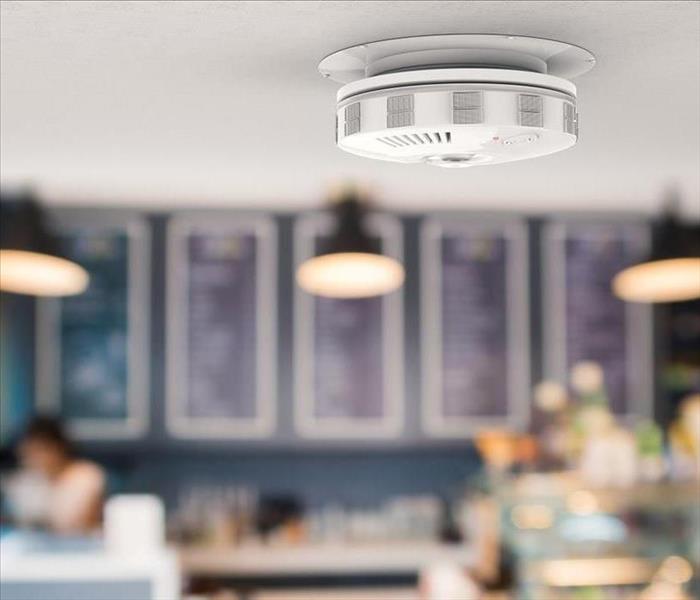 SERVPRO of Paulding/Polk counties is on standby to help you create your Emergency Ready Plan.
SERVPRO of Paulding/Polk counties is on standby to help you create your Emergency Ready Plan.
It is important for any household to practice fire safety as a regular part of their routine. House fires can be both devastating and dangerous, and on average, those in the household will have less than three minutes to escape should a fire begin.
Fortunately, by being vigilant about the prevention of house fires, you can reduce the likelihood of you ever having to experience one. While there is no way to completely eradicate your risk, there are plenty of steps you can take to make your home less susceptible to accidental fires breaking out.
A Checklist for Household Fire Safety
Practicing fire safety is a great way to reduce your risk of experiencing a fire at your home. By referencing this simple checklist, you can be sure you are taking necessary precautions to keep your household safe.
**Smoke Alarms**
* Ensure that you have smoke alarms on each level of the home and in every sleeping area.
* Test smoke alarms each month and replace batteries as needed.
* Note the install date for all alarms and replace after 10 years, even if they are still operational.
**Cooking Safety**
* Be sure to never leave the stove or oven on unattended.
* Keep flammable items, such as towels and wooden utensils, three feet from the stove.
* Store a fire extinguisher prominently in the kitchen.
* Understand the difference between grease fires and other types of fires, and know the methods for extinguishing each.
**General Safety**
* Be sure your household has a fire escape plan that you practice at least twice per year.
* Ensure that every area of your home has at least two exits.
* Store any flammable chemicals in accordance with their label recommendations.
* Keep matches, lighters and other flammable objects away from young children.
* Do not leave candles lit if they are unattended.
* Keep anything flammable at least three feet away from candles, space heaters or other sources of heat.
**Electrical Safety**
* Never overload electrical outlets or extension cords.
* Replace any frayed cords or wires immediately.
* Plug appliances and any heat-generating items directly into the wall, not into extension cords.
* If wall outlets ever feel warm to the touch, stop using them immediately and call an electrician.
*If you have damage from a fire, you can count on us to help. We are here 24/7 for restoration—contact us today to learn more about our processes.
Where to Start on Fire Safety Efforts for the Home
2/3/2022 (Permalink)
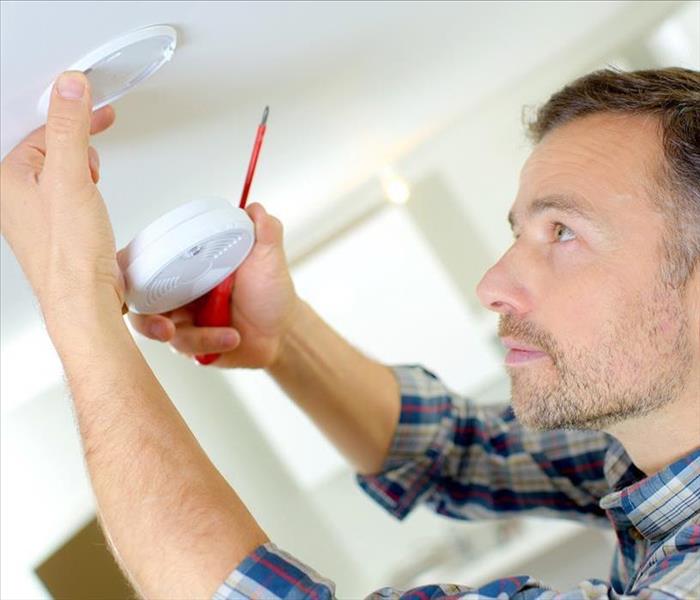 SERVPRO of Paulding/Polk counties is ready 24/7 to help you get prepared for emergencies.
SERVPRO of Paulding/Polk counties is ready 24/7 to help you get prepared for emergencies.
If you are hoping to improve your household fire safety, it can be overwhelming to know where to start. House fires are certainly dangerous, but given the multitude of ways they can start, understanding what fire prevention measures to take around the home can seem like it will be a daunting task.
Fortunately, fire safety is actually quite simple! By adding certain habits into your household routines, you can make major strides in reducing your likelihood of a fire and keeping your family safer.
Read on to learn more regarding where to start when improving fire safety in the home.
How to Begin Your Fire Safety Efforts at Home
**Start with your smoke alarms.** If you are new to fire safety efforts, starting with smoke alarms is really the best thing that you can do. Most people will have less than three minutes to escape when a fire begins in the home, but smoke alarms can ensure all members of your household are alerted quickly so they can begin evacuating. Make sure you have smoke alarms installed throughout each level of the home and in every sleeping area, and test them once per month to be sure they are operational and do not need a battery replacement.
**Create an escape plan.** As previously mentioned, being able to escape quickly is so important in the event of a house fire. It is wise to draft a fire escape plan for your home, and practice it with each member of your household at least every six months. Be sure that you are able to execute your plan in around two minutes, and that everyone knows where to meet up once they are safely outside.
**Consider your cooking habits.** Cooking is one of the most common causes of house fires, so evaluating your cooking habits can be a great way to prevent fires from starting. Be careful about flammable objects near the stove and leaving food unattended while cooking. Additionally, make sure that you have a fire extinguisher in the kitchen that is rated to handle cooking and grease-related fires.
*If you have damage to your home from a house fire, we are the team to call. We are here 24/7 to provide you with a rapid response. Get in touch today to learn more.*
Breaking Down the Fire Tetrahedron
2/2/2022 (Permalink)
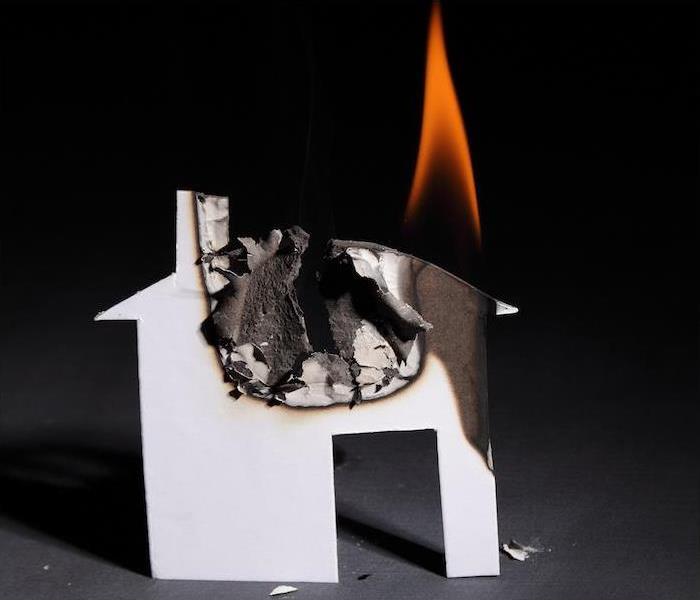 If your home or business has any damage, SERVPRO of Paulding/Polk is ready around the clock to help you recover.
If your home or business has any damage, SERVPRO of Paulding/Polk is ready around the clock to help you recover.
First things first, do you know the definition of a tetrahedron? To cut down on time, let us explain…it’s a three-dimensional, triangular shape with four equal sides.
Now that you know the basics of the geometric shape, let’s discuss what a fire tetrahedron is.
Basically, it’s a way of acknowledging that there are four components needed for fire to start—or four “sides” to the equation. If one of the sides is removed, the structure can’t stand and the fire can’t start.
The 4 Things a Fire Needs to LiveFuel. Fire, like people, needs fuel to keep going. It can be organic or inorganic, but there has to be some source of fuel for a fire to start, such as wood or plastic.
Heat. The amount of heat needed to start a fire varies from substance to substance. But you must have enough heat to cause combustion. Every object has a set point at which it will combust, melting or igniting.
Oxygen. Fire reacts with oxygen to produce a series of chemical reactions. In short, oxygen feeds the fire so that it can keep growing and generates products of combustion in the process.
Chemical Chain Reaction. The cycle of heat, fuel and oxygen combine to produce a chain reaction. This will perpetuate a fire as long as the chain reaction is undisturbed.
The 4 Ways to Stop a FireCool it. This is the most common method for extinguishing a fire, and the most common form of cooling is the application of water. Eventually, when dousing the flames with water, they reach a temperature below what’s needed to sustain a fire.
Smother it. If a fire doesn’t have access to oxygen, then it can’t live. To smother it, you must deprive it of oxygen. This can be a simple task like snuffing a candle, or it can be a little more difficult because it might need chemicals introduced.
Starve it. When a fire burns with no outside interference, it will likely burn until it runs out of adequate fuel. To be proactive, you should remove the fuel source while the fire is still trying to consume it.
Interrupt the chain reaction. Chemical agents can effectively disrupt a chain reaction and put a fire out. One chemical agent that is very effective is halon, but it has an elevated potential for ozone depletion, making it an environmental threat.
If the fire tetrahedron makes a wreck of your home or business, we’re ready around the clock to help you recover. Contact SERVPRO anytime for fast, thorough cleanup and recovery after a fire.
Creating Your Home’s Fire Safety Blueprint
1/31/2022 (Permalink)
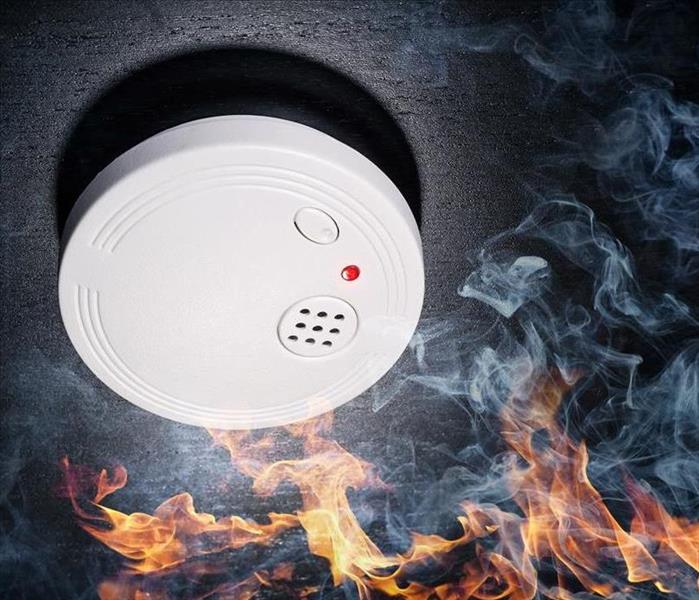 Creating a Safety Blueprint for your home is a great way to get prepared. Let SERVPRO of Paulding/Polk Counties help you make a plan.
Creating a Safety Blueprint for your home is a great way to get prepared. Let SERVPRO of Paulding/Polk Counties help you make a plan.
Increasing the fire safety of your home is a great goal. House fires can be traumatic and dangerous events, causing extensive property damage as well as injury or loss of life. However, if you have not previously considered your options for fire safety, getting into the habit of fire prevention around the house may seem like a daunting task.
The good news is that improving your home’s fire safety is ultimately quite a simple task. Once you assess where your gaps in fire prevention efforts are, you can implement simple new habits to better protect your home.
Below, we will help you identify where you could improve fire safety so you can figure out exactly what you can do to help keep your household safer from fires.
Determining Where to Improve Your Fire Safety at Home
**Consider personal safety first.** While fire prevention is quite important, the first thing you should do from a safety perspective is to consider how to protect your family if a fire does start. One of the best things you can do is install smoke alarms throughout the home and test them monthly to ensure they are operational. That way, anyone in the home will be alerted right away if a fire starts and can quickly get to safety. Additionally, you should draft a fire evacuation plan for your household and practice it regularly, so everyone is aware of what to do if the alarms do sound.
**Next, consider your daily habits.** Because many fires are started due to seemingly innocuous errors around the home, it is important to consider how your daily habits could have a role in your fire safety efforts. On average, how careful are you when cooking, lighting candles and utilizing flammable objects? Being aware of little things, like keeping flammable objects away from heat sources, can go a long way toward safety.
**Know the fire risks to watch for.** In addition to building good habits, knowing when to identify a fire risk is an important part of the puzzle. Things such as overloaded extension cords, frayed wires or space heaters being used improperly are red flags regarding fire safety—and quickly addressing them can go a long way towards prevention.
*If you have damage due to a fire in your home, you can count on us for restoration. Get in touch today to learn more about how we can help.
Fire Safety Myths About the Festive Season
12/20/2021 (Permalink)
 If you experience a holiday house fire, you can count on SERVPRO of Paulding/Polk Counties 24/7, 365 to begin your fire restoration process.
If you experience a holiday house fire, you can count on SERVPRO of Paulding/Polk Counties 24/7, 365 to begin your fire restoration process.
Fire safety is something that is always important for a household to practice, but did you know
that some seasons tend to be more dangerous than others? Winter is the most common time of
year that a house fire will break out, and there are many reasons why this could be the case.
Part of the reason why fires are so common during the wintertime has to do with the way we
celebrate the holidays. From dangerous décor to cooking conundrums, there are a lot of
opportunities to let fire safety lag when the Christmas season rolls around.
If you have not considered how to be fire-safe during this festive time, read on as we dispel
myths that might be hazardous.
Dispelling Fire Safety Myths for the Holidays
Fake Christmas trees are a fire hazard. While fake Christmas trees might be flammable, real
Christmas trees are actually a much larger fire hazard. While they certainly can be used safely,
it is vital to water the tree every day, avoid putting it near any heat sources and never allow it to be near an open flame. Dried needles are extremely combustible, so exercising caution is key.
Christmas lights are a safe alternative to candles. Before electricity, candles were a common form of Christmas decoration. While lights are certainly a safer alternative, lights can be dangerous, too. Strands that are frayed or damaged can spark and cause a fire, and plugging in too many lights together can be a serious fire hazard, too. While Christmas lights are much safer than candles for decoration, they still have their own dangers that should be considered.
It is safe to leave lights on overnight. While having your house decorated for the holidays is
an exciting thing, it is important that you do not leave your electric decorations on when they will
be unattended. Always unplug lights before going to sleep or leaving the house—if a fire were to
begin due to your lights, this would prevent it from happening at a time where it is more likely to go unnoticed by you and your household.
If you experience a holiday house fire, you can count on us. We are here 24/7, 365 to begin your fire restoration process. Contact us today to learn more about the services we offer.
Fall Fire Safety
10/6/2021 (Permalink)
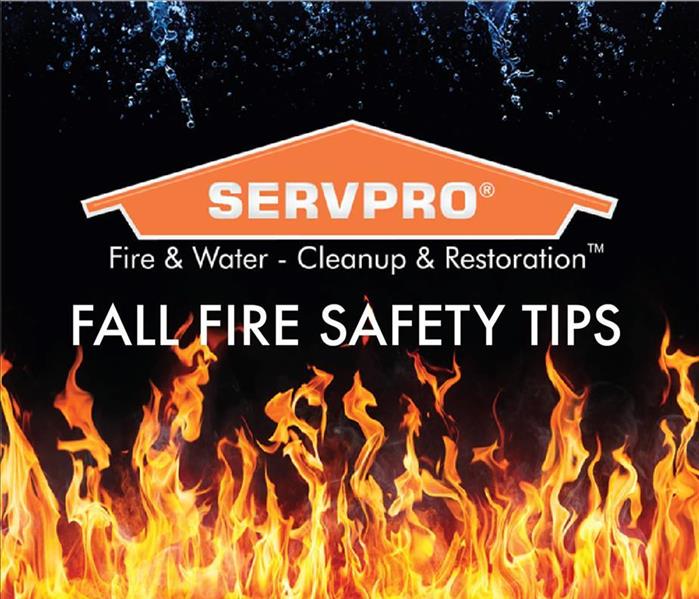 Trust the experts at SERVPRO of Paulding/Polk Counties should you have fire damage at your home or business.
Trust the experts at SERVPRO of Paulding/Polk Counties should you have fire damage at your home or business.
The fall season brings cooler temperatures, beautiful colors, and an abundance of outdoor activities. Plan ahead this season to help ensure it is safe from potential fire hazards.
According to the National Fire Protection Agency, cooking fires are the number one cause of home fires and injuries. The leading cause of fires in the kitchen is unattended cooking. Here are some helpful hints when cooking your fall family dinners.
• Stay in the kitchen while you are frying, grilling, boiling, or broiling food.
• If you are simmering, baking, or roasting food, check it regularly, remain in the kitchen while the food is cooking, and use a timer to remind you that you are cooking.
• Keep anything that can catch fire, like oven mitts, wooden utensils, food packaging, or hand towels, away from the stovetop.
If you have a cooking fire, consider the following safety protocols to help keep you and your family safe.
• Just get out! When you leave, close the door behind you to help contain the flames.
• Call 911 or the local emergency number after you get out safely.
• For an oven fire, turn off the heat and keep the oven door closed.
• If you try to fight the fire, be sure others are getting out and you have a clear path out.
• Keep a lid nearby when you’re cooking to smother small grease fires. Smother the fire by sliding the lid over the pan and turn off the stovetop. Leave the pan covered until it is completely cooled.
If you are doing any outdoor cooking around a fire pit, consider the following to keep it a fun, but safe time for all:
• Check the wind conditions prior to starting the fire. Wind can make it hard to light the fire or blow embers around to surrounding brush or structures.
• Always have a fire extinguisher or water source nearby, like a water hose or water bucket.
• Never leave the fire unattended.
• Keep all children and pets at least three feet from the fire.
Destroy Odors with Deodorization
9/13/2021 (Permalink)
Even a small fire can cause odors for years to come if the affected areas are not properly cleaned and deodorized. Fire, smoke and soot damage in your home or business can create unpleasant and potentially permanent problems.
As various materials burn, the smoke produced travels throughout the structure, leaving odorous residues and deposits on surfaces and in hard-to-reach places. Unless fast, professional action is taken, these residues and deposits can cause permanent damage to contents and may result in resurfacing odors.
With technicians certified by the Institute of Inspection, Cleaning and Restoration (IICRC), SERVPRO® of Paulding/Polk Counties professionals provide specialized services that can rid your home or business of offensive odors left by fire or smoke damage. SERVPRO® of Paulding/Polk Counties professionals do not cover up lingering odors with a fragrance; they seek out and remove the source of the odor. Once the source is found, SERVPRO’s own proprietary line of cleaning products is used to treat and prevent the odor from returning. Any restorable item in affected areas will also be professionally cleaned and deodorized, including furniture, draperies and upholstery, electronics, art, flooring, walls, ceilings, HVAC air ducts and more.
Ask SERVPRO® of Paulding/Polk Counties to explain the various deodorization methods available and which will work best for you.
If you or a customer suffer a fire damage or some other accident and require deodorization services, contact SERVPRO® of Paulding/Polk Counties. Whether it’s fire, water, or mold damage or just a stubborn odor that refuses to go away, we’ll help make it “Like it never even happened.”
Deep Fryer Safety
8/25/2021 (Permalink)
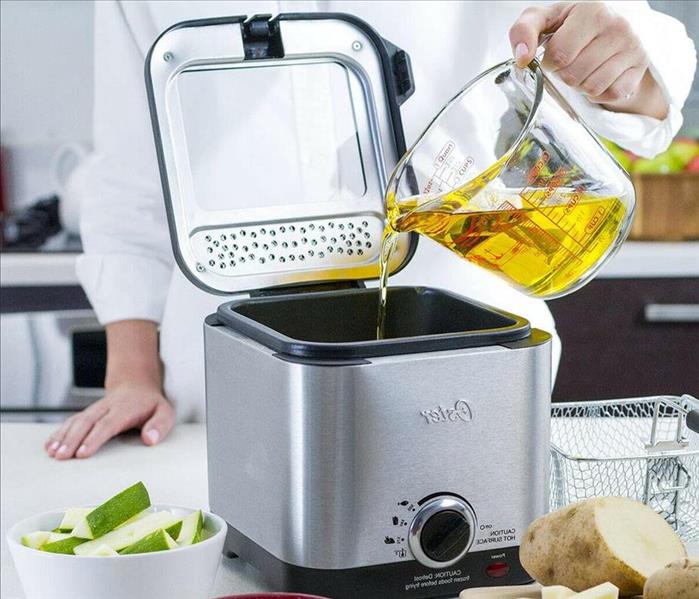 SERVPRO of Paulding/Polk Counties are your local experts to help you turn that kitchen fire damage back into a functioning kitchen.
SERVPRO of Paulding/Polk Counties are your local experts to help you turn that kitchen fire damage back into a functioning kitchen.
Here in the south, fried foods are a necessary food group. It's as essential to our way of life as sweet tea. Frying foods at home is much easier thanks to residential deep fryers. So if you find yourself hankering for some fried chicken or veggies, following these tips to ensure you don't need to call the fire department or SERVPRO of Paulding/Polk Counties.
*Know your oil smoke point. Each type of cooking oil has it's own smoke point. This is the temperature that your oil begins to smoke and could catch fire.
*Don’t overfill your deep fryer. Most deep fryers have a max fill line. What most people don't account for is that this should include the food, not just the oil. Overfilling your deep fryer could result in spilling oil and causing a fire and uneven cooking due to the oil temperature dropping.
*Do not deep fry wet food. Water can cause hot oil to splash and spill over potentially resulting in a fire. Most frozen foods are already mostly dry, but fresh foods can contain a lot of moisture and need to be patted down before putting in hot oil.
*Keep your deep fryer in clear surroundings. Many deep fryers aren't cool to the touch when cooking. Make sure the are around your deep fryer is free from flammable and combustible materials.
*Make sure your deep fryer has a break-away cord. This is a standard safety feature on most home deep fryers to keep the fryer from tipping over if the cord is tripped up by something or someone. However, not all have this so inspect yours and use accordingly.
*Have a lid on hand. While not necessary, smothering is the safest way to put out a grease fire. If your deep fryer doesn't come with a lid, find something you can use that will work just as well.
*Keep a fire extinguisher handy. There are many people who've never thought to have a fire extinguisher in their kitchen in case of a fire. There are many options available for a fire extinguisher made for home use, so make sure you have one to on hand in your kitchen.
*Keep track of your temperatures. Many deep fryers have a built in temperature gauge to track how hot your oil is and make sure your fryer is cooking at the proper heat. These can malfunction so having a separate clip-on thermometer as a back up is a great idea.
*Dispose of oil properly. Always let the oil cool down completely before storing or disposing of it. If storing, make sure to filter out all food particles so your oil doesn't spoil prematurely. If disposing, make sure to pour into a air tight container. Never pour oil down a drain as it can cause the drain to clog and back up.
*Use proper protective equipment. Most foods won't splatter as long as excess moisture is removed, but fatty foods like bacon will splatter regardless. Using the handle on the fryer basket will protect you, but having protective gloves as secondary protection is always a good idea.
Should you find yourself faced with a kitchen fire, trust the experts at SERVPRO of Paulding/Polk Counties to help you make it "Like it never even happened."
*Source: Deep Fryer Safety Tips
Do you know the different types of smoke damage?
7/26/2021 (Permalink)
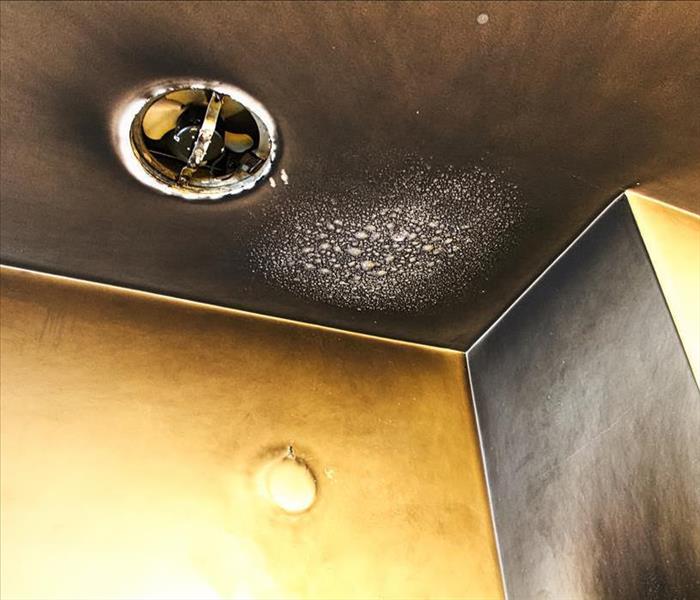 If you are in need of restoration due to fire and smoke damage, you can count on SERVPRO of Paulding/Polk Counties.
If you are in need of restoration due to fire and smoke damage, you can count on SERVPRO of Paulding/Polk Counties.
Every house fire is unique and causes specific types of damage based on what the initial source was, how long it burned and what was consumed by the flames. One of the ways that fire damage can manifest itself is via smoke residue left behind throughout the house.
The severity of smoke damage depends on several factors, but identifying it quickly and calling in your restoration team to have it handled is always recommended.
The Types of Smoke Damage That May be Present After a Fire
Wet Smoke Damage. Damage from wet smoke is generally a result of fires that burn at a lower temperature. These fires do not have as many flames but will produce an excess of smoke that can thickly coat the surfaces of your home. It can often feel sticky and wet to the touch, hence the name. Because of how it adheres to surfaces and saturates the air with a strong odor, wet smoke is one of the most difficult types to eradicate from a home.
Dry Smoke Damage. A hot, high-temperature fire such as one from a flammable liquid or a large number of open flames will produce a more dry smoke. This will result in smoke residue that is dry and powdery, which can settle into minuscule crevices and impact areas relatively far away from where the flames broke out in the home.
Protein Smoke. Associated with foods or other flammable organic materials catching fire, protein smoke is a unique type that results in a buildup of soot. Soot is quite dangerous, and this type of soot is generally difficult to see because it will be light in color. The residue it leaves behind is typically easy to feel, however, and it will likely cause a lingering odor as well.
Petroleum Smoke. Any time an oil-based material is burned, it will let off petroleum smoke. It produces an extreme odor and is generally quite dark in color, which can permanently discolor upholstery or wood if left untreated.
If you are in need of restoration due to fire and smoke damage, you can count on us. Call us today (770) 505-0555 to learn more.
Understanding the Classes of Fire Damage
7/21/2021 (Permalink)
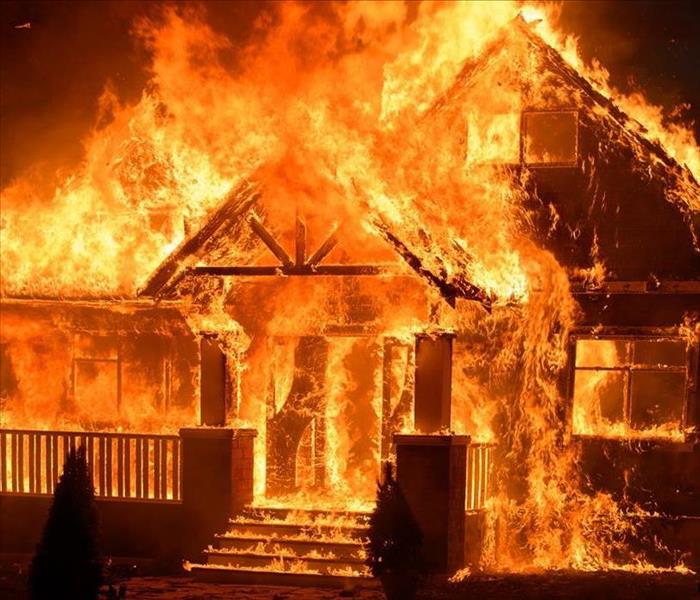 If you have had fire damage to your home, SERVPRO of Paulding/Polk Counties can help out.
If you have had fire damage to your home, SERVPRO of Paulding/Polk Counties can help out.
If you have experienced a fire in your home, you are likely navigating through the complicated aftermath of assessing the damage, filing an insurance claim and obtaining trusted home restoration to take care of the damages.
Throughout this process, firefighters, insurance agents and restoration teams will want to discuss the damage with you, so it is important to understand exactly what they mean.
Professionals use a series of classes to evaluate fire damage in order to create an organized system. The classes of fire damage have to do with the fire’s origins, as many times, this will indicate the type of damage that is caused. The start of the fire and the combustible materials involved have a large bearing on the extent and severity of the damage, so here is a guide to common terms you may come across.
The 6 Classes of Fire Damage
Class A: Class A fire damage is a result of a fire that occurs when flammable, solid materials are ignited, such as wood, cloth, paper and plastic.
Class B: When a fire starts due to liquids that are ignited—or in some cases, flammable solids that turn to liquids—it is considered Class B damage. This is the class designated for fires related to gasoline and other flammable chemicals that might be the source of the flames.
Class C: Any flammable gas, such as propane, butane and any others, will lead to Class C fire damage.
Class D: There are combustible metals that can cause fires, and if they do, they will cause Class D fire damage. Magnesium, potassium and sodium are all examples of combustible metals that can cause fires.
Class E: Class E is actually quite similar to Class A and B, but has to involve an electrical component as well. It will still require a fire due to flammable solids or liquids, but these items will be ignited by an electrical spark to be considered Class E.
Class F: This type of fire damage is similar to Class B because it involves ignition from cooking oils and fats, but these often burn much hotter and cause much more severe damage than a Class B fire.
If you have had fire damage to your home, we can help out. Contact us at any hour (770) 505-0555 to learn more about our fire restoration process and get a quick response to your home or business




 24/7 Emergency Service
24/7 Emergency Service















